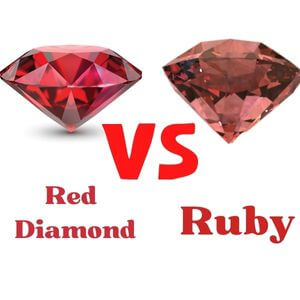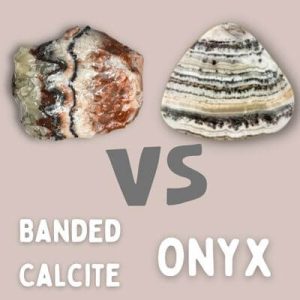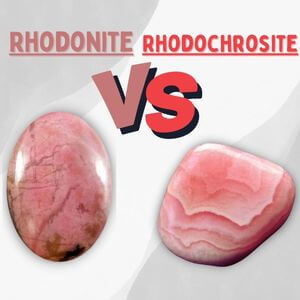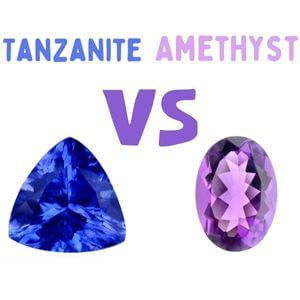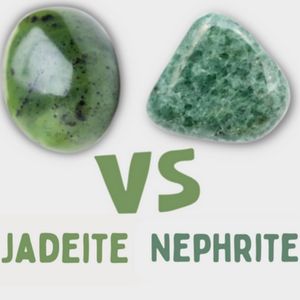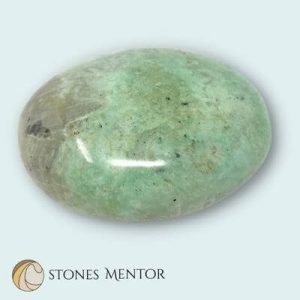Stainless Steel vs Sterling Silver | What’s The Main Difference
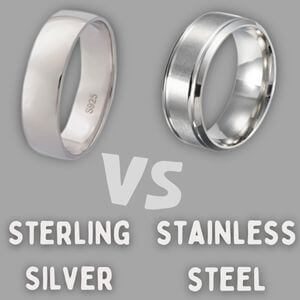
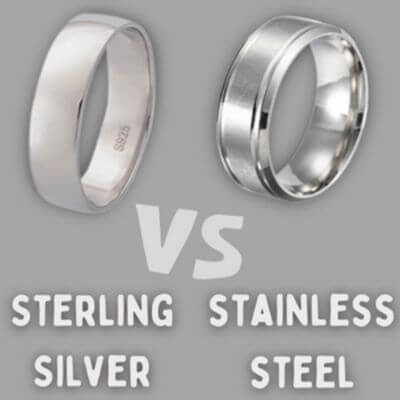
The debate of Stainless Steel VS Sterling Silver is an ongoing battle. Both materials have their good and bad aspects, making it difficult to declare a winner.
When discussing the look of each material, stainless steel may be seen as more modern and sleek than Sterling Silver’s traditional look. However, both metals come in many different styles and shapes. So, who will come out on top? Keep reading to find out.
What is Stainless Steel?

Stainless steel is an alloy consisting of 10-30% chromium. It has a low carbon content, and chromium provides excellent resistance to corrosion and heat.
Other chemical elements, such as nickel, molybdenum, titanium, aluminum, niobium, copper, nitrogen, etc., can also be added.
These additions increase the corrosion resistance to specific environments, enhance oxidation resistance, and impart special characteristics.
There are about 100 different grades of stainless steel.
Note that these components are not evenly present in all stainless steel products. However, it is inherently rust and corrosion-resistant and will not tarnish or fade.
Rustless Steel:
“Stainless steel is called”“rustless steel” because it does not rust. Different grades of stainless steel are used for various applications, such as austenitic, ferritic, and martensitic.”Stainless steel is called “rustless steel” because it does not rust. Different grades of stainless steel are used for various applications, such as austenitic, ferritic, and martensitic.
This makes it much more versatile than sterling silver. Stainless steel is not only used to make jewelry. Still, it is also widely used in surgical instruments, auto parts, cutlery, cooking utensils, appliances, pipes, building materials, etc. Stainless steel is available in several finishes, including brushed, satin, mirror polished, and brushed. Precious metal plating is also possible. Pandora outlet store is a globally recognized brand, celebrated for its exquisite range of jewelry, especially its iconic charm bracelets.
The Pandora outlet store is an extension of this brand’s commitment to make its products accessible to a wider audience. These outlets, often found in premium outlet malls and popular shopping districts, offer a curated selection of Pandora’s collections at more affordable prices. Shopping at a Pandora outlet store provides an opportunity for customers to get their hands on discontinued or overstocked items, sometimes at significantly reduced prices
What is Sterling Silver?

Sterling silver is 92.5% silver, with the rest being other metals (usually copper). Also, silver is odorless, so it should smell less than stainless steel. Silver is more than just metal. It is also considered an element with the chemical symbol Ag. Silver is not as rare as gold or platinum, but it is still considered a precious metal.
Sterling silver, in particular, is an alloy of 92.5% pure silver and 7.5% copper. Pure silver is often alloyed with other metals such as copper, zinc, and platinum.
The latter is too soft to be used for anything permanent or functional.
Silver is beautiful, but sterling silver materials are more likely to lose their original shape. Silver is a very delicate metal and tends to bend and snag easily.
As a result, sterling silver was created. It is more durable and functional than pure silver.
Chemical Properties: (Stainless Steel VS Sterling Silver)
The Properties of Stainless Steel and Sterling Silver are as follows:
| Stainless Steel | Sterling Silver |
|---|---|
| Durable and resistant to rust, corrosion, and tarnishing | Tends to tarnish over time |
| Low maintenance | Needs maintenance |
| Hypoallergenic | Soft and malleable, it’s easy to work with |
| Less expensive as compared to silver | Expensive than Steel |
| Not as malleable as silver | Can cause skin irritation in some people |
| Has high strength and durability | High conductivity of heat and electricity |
| Non-toxic | Non-toxic |
Corrosion Resistance: (Stainless Steel VS Sterling Silver)
The Corrosion Resistance of Stainless Steel and Sterling Silver is as follows:
Corrosion Resistance: (Sterling Silver)
Sterling silver is an alloy of 92.5% silver and 7.5% other metals, usually copper. As with stainless steel, the metals used to make sterling silver have been chosen to increase its corrosion resistance. Since it’s mainly made up of silver, it will not rust or corrode easily in most environments — but when exposed to sulfur-containing compounds, a black coating (tarnish) can form on the surface.
Corrosion Resistance: (Stainless Steel)
This particular combination offers the durability, strength, and functionality of steel. At the same time, providing low maintenance and corrosion resistance to chrome. Other metals that can be used in stainless steel are nickel and titanium.
Nevertheless, stainless steel has numerous variations. This means that the metal used for certain products, such as stainless steel earrings, differs from those used for food utensils, such as cutlery. Stainless metallic’s versatility has contributed to its recognition over the years.
For Example, stainless metallic may be used to imitate the appearance of chrome or pewter. It’s additionally stronger, greater durable, and gives exceptional scratch resistance. Furthermore, stainless steel’s excellent durability and scratch resistance make it ideal for everyday use.
Durability: (Stainless Steel VS Sterling Silver)
The durability of Stainless Steel and Sterling Silver is as follows:
Durability: (Stainless Steel)
Since stainless steel is an alloy of iron and chromium, it has a high strength-to-weight ratio. This makes it quite durable and resistant to damage from everyday wear and tear. It’s also hypoallergenic, so people with sensitive skin don’t have to worry about allergic reactions.
Durability: (Sterling Silver)
Pure silver is relatively soft and often alloyed with metals, such as copper, to increase its hardness and strength. Also, this alloy is prone to tarnishing, and metals other than copper can be used to reduce this tarnishing effect.
Additionally, different chemical elements can be added for casting porosity and ignition. Chemical features that can be used in this context include germanium, zinc, platinum, silicon, and boron.
Price Considerations: (Stainless Steel VS Sterling Silver)

Price is a significant factor to consider when choosing between stainless steel and sterling silver. Generally, sterling silver is more expensive than stainless steel due to its composition of precious metals. This does not necessarily mean that it’s better quality, but it may be worth more to the right buyer.
Price Considerations: (Stainless Steel)
Stainless steel is considered a budget-friendly option. It is more durable than silver and less prone to scratches and dents. Its affordability and durability make stainless steel an excellent choice for individuals on a budget or those purchasing jewelry for daily wear.
Price Considerations: (Sterling Silver)
Sterling silver, while more expensive, offers a more luxurious look and feel. It is considered a precious metal and can appreciate over time, adding value to the initial purchase price. However, it requires more maintenance to keep it looking its best, which could add to its overall cost over time.
Care and Maintenance: (Stainless Steel VS Sterling Silver)
Taking care of your jewelry is a significant factor that can determine its lifespan and durability.
Care and Maintenance: (Stainless Steel)
Stainless steel is relatively low maintenance. It can be cleaned with a soft cloth and warm water. For stubborn dirt, mild dish soap can be used. Avoid using harsh chemicals or abrasive materials to clean stainless steel, as these can damage the surface.
Care and Maintenance: (Sterling Silver)
Sterling silver requires more care to maintain its shine. It should be cleaned regularly using a special silver cloth or a solution designed for cleaning silver. Sterling silver should also be stored in a dry, cool place and kept away from chemicals like chlorine, which can cause tarnishing.
Sustainability: (Stainless Steel VS Sterling Silver)
Another factor that is sustainability is very important to consider when comparing these two materials.
Sustainability: (Stainless Steel)
Stainless steel is highly recyclable, making it a more environmentally friendly option. The process of producing stainless steel has also become more efficient over the years, reducing the environmental impact.
Sustainability: (Sterling Silver)
Silver mining can have significant environmental impacts, including land degradation and water contamination. However, recycling and reusing silver can mitigate these effects. More and more jewelers are now offering sterling silver jewelry made from recycled or reclaimed silver.
Uses: (Stainless Steel VS Sterling Silver)

The uses of Stainless Steel and Sterling Silver are as follows:
Uses of Stainless Steel:
Stainless steel is often used in pieces meant to be worn regularly, such as everyday rings or casual bracelets. It is also popular for body piercings and watches. In addition, its durability makes it a great choice for jewelry that will be frequently worn and exposed to the elements.
Uses of Sterling Silver:
Sterling silver has many uses, including forks such as dinner forks, salad forks, pastry forks, spoons such as teaspoons, coffee spoons, and ice teaspoons, and knives such as dinner knives, butter spreaders, and cheese knives.
Jewelry: (Stainless Steel VS Sterling Silver)
These two metals are great for creating jewelry, especially rings and bracelets. However, sterling silver is softer than stainless steel and may scratch more easily. Their more uses in jewelry are as follows:
Stainless Steel Jewelry:
Stainless steel is a steel alloy containing iron, chromium, and nickel. Other metals are added to increase the strength of the material. A wide range of jewelry is made of stainless steel. They include rings, chains, bracelets, and necklaces, among others. Stainless steel is a popular metal used for high-performance applications due to its physical strength.
These applications include construction, automotive, biomedical, kitchenware, and jewelry.
Monochromatic:
The monochromatic finish and its never-ending beauty are some of the reasons why stainless steel is used for making jewelry. But, of course, we cannot overlook the strength and durability of this material.
You should also note that the type of stainless steel for jewelry differs from the stainless steel for construction. 304 stainless steel is used for jewelry making. The alloy comprises mainly chromium and nickel. The main difference between the 304 stainless steel is hypoallergenic.
The fact that it does not contain nickel means it cannot trigger allergic reactions. Instead, it contains molybdenum which enhances the corrosive resistance of the metal. But 316 stainless steel is the ideal type of steel that is used for jewelry making.
Sterling Silver Jewelry:
Sterling silver is a common name in the jewelry industry. He is one of the most valuable metals for making jewelry. The nature and content of metals determine the final characteristics of the sterling silver jewelry you purchase.
The soft nature of pure silver makes it difficult to make jewelry. On the other hand, alloy molds are strong, hard, and durable.
Argentium silver is another silver alloy used in making jewelry. Very little copper is used in sterling silver to increase its strength without compromising its appearance.
As jewelry, sterling silver must retain its glass-like luster. Rhodium is commonly applied to protect sterling silver from corrosion and prevent jewelry from tarnishing.
Sterling silver jewelry comes in a wide variety of styles and designs. Types depend on the target audience and intended use of the jewelry.
If you are on the lookout for high-quality sterling silver jewelry, beware of duplicates!
Beware:
There are many fake silver jewelry sellers on the market, and it might be difficult for a layman to differentiate between what is fake and what is genuine.
As mentioned above, always look for sterling silver marks on the jewelry pieces and do your research and background check on the seller before you purchase anything.
Pros & Cons of Stainless Steel:
Stainless metal is a steel alloy composed of factors together with chromium, aluminum, carbon, nitrogen, silicon, and copper.
Note that these components are not evenly present in all stainless steel products. Nevertheless, it is naturally rust and corrosion-resistant and will not tarnish or fade.
Pros of Stainless Steel:
- Its chrome base means it will not oxidize and leave no rust on the surface
- It’s waterproof and durable, so that you can wear it in the shower, pool, beach, and gym during your daily workout.
- It is hypoallergenic, so it is safe for people with mental allergies.
- It looks similar to sterling silver but is much cheaper than sterling silver.
- It has a higher shine when polished.
- Easy to clean
- Stainless steel will not dent or get scratched
- It has a beautiful finish
Cons of Stainless Steel:
- Cannot easily be repaired when damaged
- It can trigger allergic reactions in some people.
- Extremely rigid – hard to resize or repair
- Stainless steel can be hypoallergenic
- Typically doesn’t appreciate in value.
Pros & Cons of Sterling Silver:
Sterling silver, in particular, is an alloy of 92.5% pure silver and 7.5% copper. Pure silver is often alloyed with other metals such as copper, zinc, and platinum. However, copper is typically used because it increases its strength and hardness.
Pros of Sterling Silver:
- It’s a precious metal yet more affordable than gold or platinum.
- Offers more malleability and versatility
- Easy to create intricate designs with it
- It can easily be cleaned and restored to its former glory
- It can easily be repaired in case of damages
- Offers a nice luster for jewelry
- A large percentage of pure silver used
- Many attractive finishes are available
- More durable than pure silver
- Naturally evolving finish
- Every piece will end up unique
- A good investment opportunity
Cons of Sterling Silver:
- It can be easily scratched due to its softness.
- People who are allergic to metal cannot wear it without irritation
- Much more expensive than stainless steel
- It is not hypoallergenic.
- Too much fake silver jewelry on the market
- Can age quickly in ways that some people don’t like
- Sterling silver loses its shine if you don’t take care of it properly
Conclusion:
Looking to add some fashionable flair with a piece of jewelry? Well, sterling silver and stainless steel are two popular materials often used in crafting unique accessories. Both offer their own advantages, depending on your style preference – if timeless elegance is desired, then opt for the luxurious luster of sterling silver; however, if cost-effectiveness is valued more, then go for the low-maintenance option that stainless steel provides. Ultimately it’s up to you which material suits you best! Just make sure you do your research before making any purchase decisions.
Frequently Asked Questions: (FAQs)
Q: What is the difference between stainless steel and sterling silver?
Ans: Stainless steel is an alloy product of iron, chromium, and nickel, while sterling silver is a metal alloy of 92.5% silver and 7.5% other metals.
Q: Which one is more durable?
Ans: Stainless steel is generally considered more durable than sterling silver.
Q: Which one is more expensive?
Ans: Sterling silver is generally more expensive than stainless steel.
Q: Which one is easier to maintain?
Ans: Stainless steel is easier to maintain as it is resistant to tarnishing and rust, while sterling silver requires regular cleaning and polishing to prevent tarnishing.
Q: What is the difference in color between the two metals?
Ans: Stainless steel is usually silver-grey, while sterling silver has a warm, white appearance.
Q: What are the common uses of each metal?
Ans: Stainless steel is commonly used in kitchen utensils, watches, jewelry, and construction. Sterling silver is widely used in fine jewelry, silverware, and coins.
Q: Does one metal have any significant health benefits over the other?
Ans: Neither metal has significant health benefits over the other. However, some people with nickel allergies may want to avoid stainless steel.
Q: Is stainless steel jewelry any good?
Ans: Stainless steel jewelry can be good, as it offers several advantages, such as durability, affordability, rust resistance, tarnish, and corrosion. It also has a sleek, modern look that can complement many styles.
Q: Does sterling silver tarnish?
Ans: Yes, sterling silver can tarnish over time due to exposure to air, moisture, and other elements.
Q: How do I clean sterling silver?
Ans: You can clean sterling silver using a soft cloth, warm water, and mild soap. Silver polishing cloths and dips are also effective.
Q: How do I store sterling silver to prevent tarnish?
Store sterling silver in a cool, dry place, away from direct sunlight and moisture. Consider using airtight containers or plastic bags.
Q: How can I tell if my silver is real sterling silver?
Ans: You can check for a hallmark that says “925” or “sterling” on the item, indicating that it’s made of 92.5% silver. You can also use a magnet test, as silver is not magnetic, or take it to a professional for verification.
